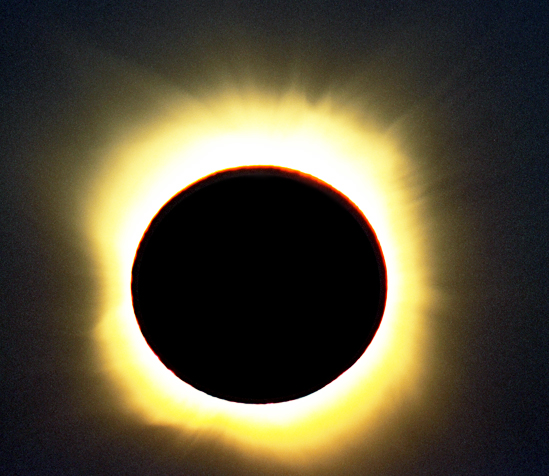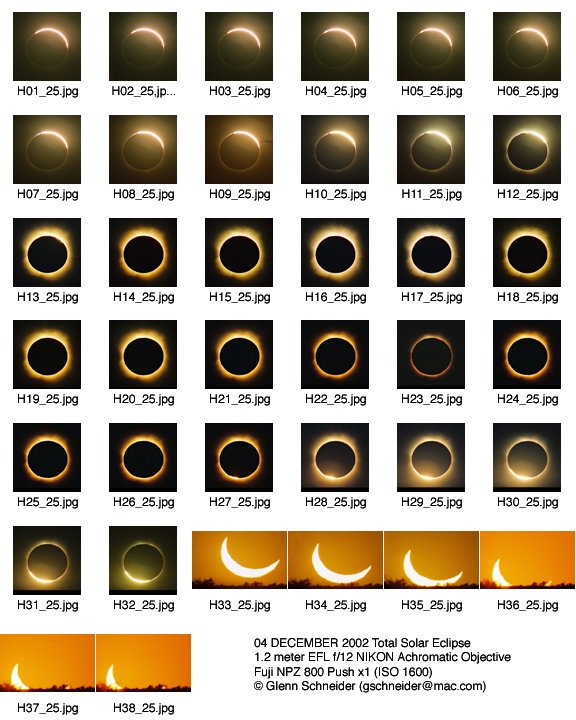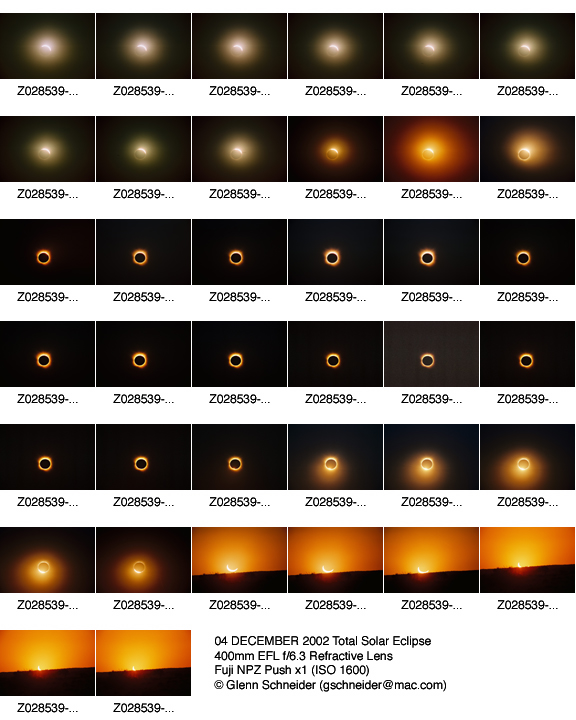04 DECEMBER 2002
LINDON STATION (FORTEVILLE BORE) SW AUSTRALIA
GLENN SCHNEIDER (gschneider@mac.com)

Click HERE for background information on the preliminary planning for this eclipse observation.

1) A "High Resolution" camera with a 1.2 meter focal length f/12 NIKON achromatic refractor objective lens (3.94" clear diameter), with two 1/8-wave fold-flats, assembled as a ridged "folded refractor".
2) A "Wide Field" camera with a 400mm f/5.6 refracting lens.
Both cameras were fixed to a common mount and operated by the UMBRAPHILE automated solar eclipse photography S/W, each under electro-mechanical control of a high-speed solenoid shutter actuator. The camera set-up is shown below:
LINDON STATION - FORTVILLE
BORE, SOUTH WEST AUSTRALIA
LATITUDE: -029° 07' 53.0''
LONGITUDE: +140° 53' 50.0''
ALTITUDE: 120 meters
With a
PREDICTED (see note on post-facto delta-T correction)
PENUMBRAL DURATION = 01:51:00.9
UMBRAL DURATION = 00:00:26.6
MAXIMUM MAGNITUDE = 1.004
and a
PREDICTED (see note post-facto delta-T correction)
Cnt hh:mm:ss.f Alt° P.A°
1ST 08:14:38.0 +13.1 274.9
2ND 09:11:25.3 +01.5 086.4
MID 09:11:38.6 +01.5
3RD 09:11:51.8 +01.4 266.5
4TH 10:05:38.9 -08.9 093.2
With Lunar Limb Corrections Applied.
EXECUTED UMBRAPHILE 2.4.1A EXPOSURE SEQUENCE
## T-cont T-mid T+CII UT of
EXP DURAT 1/DUR
1 -9.00 -22.29 -9.00 091116.26 0.100 10.00
2 -8.00 -21.29 -8.00 091117.26 0.100 10.00
3 -7.00 -20.29 -7.00 091118.26 0.100 10.00
4 -6.00 -19.29 -6.00 091119.26 0.100 10.00
5 -5.00 -18.29 -5.00 091120.26 0.100 10.00
6 -4.00 -17.29 -4.00 091121.26 0.100 10.00
7 -3.00 -16.29 -3.00 091122.26 0.100 10.00
8 -2.00 -15.29 -2.00 091123.26 0.100 10.00
9 -1.00 -14.29 -1.00 091124.26 0.100 10.00
10 0.00 -13.29 0.00 091125.26 0.050 20.00
11 2.05 -11.25 2.05 091127.31 0.088 11.35
12 4.09 -9.20 4.09 091129.35 0.155
6.44
13 6.14 -7.16 6.14 091131.40 0.274
3.65
14 8.18 -5.11 8.18 091133.44 0.483
2.07
15 10.23 -3.07 10.23 091135.49 0.851 1.18
16 12.27 -1.02 12.27 091137.53 1.500 0.67
17 12.27 1.02 14.32 091139.58 1.500 0.67
18 10.23 3.07 16.36 091141.62 0.851 1.18
19 8.18 5.11 18.41 091143.67 0.483
2.07
20 6.14 7.16 20.45 091145.71 0.274
3.65
21 4.09 9.20 22.50 091147.76 0.155
6.44
22 2.05 11.25 24.54 091149.80 0.088 11.35
23 0.00 13.29 26.59 091151.85 0.050 20.00
24 -1.00 14.29 27.59 091152.85 0.100 10.00
25 -2.00 15.29 28.59 091153.85 0.100 10.00
26 -3.00 16.29 29.59 091154.85 0.100 10.00
27 -4.00 17.29 30.59 091155.85 0.100 10.00
28 -5.00 18.29 31.59 091156.85 0.100 10.00
29 -6.00 19.29 32.59 091157.85 0.100 10.00
30 -7.00 20.29 33.59 091158.85 0.100 10.00
31 -8.00 21.29 34.59 091159.85 0.100 10.00
32 -9.00 22.29 35.59 091200.85 0.100 10.00
As defined by the Umbraphile Data File used:
Exposures 33-38 of sunset partial eclipse (unfiltered)
were triggered manually and exposed at 0.01s (1/100th second)
Images presented here are from low (512x768 pixel) resolution
scans (1.13Mb per original file).
Negatives were also scanned scanned to 4096 x 6144 higher resolution
and digitized on a Kodak Pro Photo CD,
and used to create high resolution images which may be seen (and downloaded)
HERE.
On this page NO color correction, transformations or brightness/contrast adjustments have been made.
ALL images are JPEG compressed (but at "best" quality) for web display,
and do not reflect the quality of the original photographic negatives.

CLICK HERE TO SEE THE PHOTO GALLERY FROM THE "HI-RES" CAMERA
If your browser does not support frames the individual images may be found in the Hi-Res Directory.
HI-RES images have been registered and cropped, partial phases rotated to compensate for camera tilt.
UMBRAPHILE 2002: THE MOVIE (QUICKTIME, 33.4Mbytes) in Real Elapsed Time
Using the above images I have done a bit of image processing to compensate for the facts that:
a) The exposure sequence was not temporally centered at mid-eclipse
because of the 2.5s delta-T error (mea culpa)
b) The totality exposures had a cadence of 1 frame per 2.05s, while
the diamond ring (DR) exposures were 1 frame per second
c) The planned CII and CIII exposures are shorter (by design) than
the totality and DR images on either side of them
d) The star and end of the logarithmic ramps are very slightly shorter
exposures then the DR exposures.
This sequence would have been optimal for my needs IF it were not offset from mid-eclipse. What I did was:
a) Adjust apply multiplicative scaling constants to a few selected frames
to achieve (approximately) logarithmically smooth transitions as the
background increased or decreased due to the change in the photospheric
extent but asymmetrically w.r.t. the contacts and the planned ramps
b) applied a gamma correction to those frames to re-stretch the contrast
appropriately for the adjusted dynamic range
c) augmented one frame which had excessive jitter by using the chromospheric
and prominence data from it weighted and combined with radial gradient
masking of the images on either side of it.
Then: For those frames with exposure start times spaced by 2 seconds, I created linerly-weighted (by signal-to-noise on a pixel by pixel basis) interpolated images, to "create" intermediate frames from their immediate neighbors.
It still is not perfect, I suspect because my solenoid control was probably not accurate in exposure time to better than 5-10% and some empirical adjustment may still be necessary. However, for a first unbiased crack at processing I am quite pleased with the results. Here is a:
CONTACT SHEET OF THE HI-RES DATA WITH REPROCESSING AS DESCRIBED ABOVE
And here is UMBRAPHILE 2002: THE SEQUEL (QUICKTIME, 35.0 Mbytes) in Real Elapsed Time. Yes, more frames but virtually the same size. Beats me how QUICKTIME can do that - but it all was lossless w.r.t. the input resolution. I think you will find it much improved over the original. Indeed, I think you would be hard pressed to identify which were the interpolated frames - so I put an "I" after the timecode which identifies them by name. Now, have fun moving the QuickTime slider after you see the movie.
Don't Miss This "Movie"!

CLICK HERE TO SEE THE PHOTO GALLERY FROM THE "LO-RES" CAMERA
If your browser does not support frames the individual images may be found in the Wide Field Directory.
LO-RES images are raw scans from the CD. Artifacts are from scan, not on negatives.
RETURN to Glenn
Schneider's Home Page